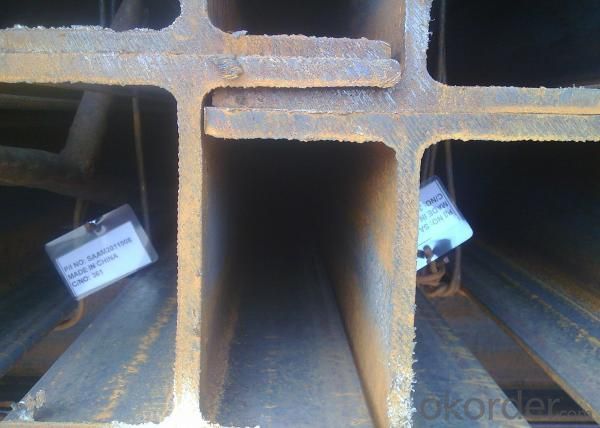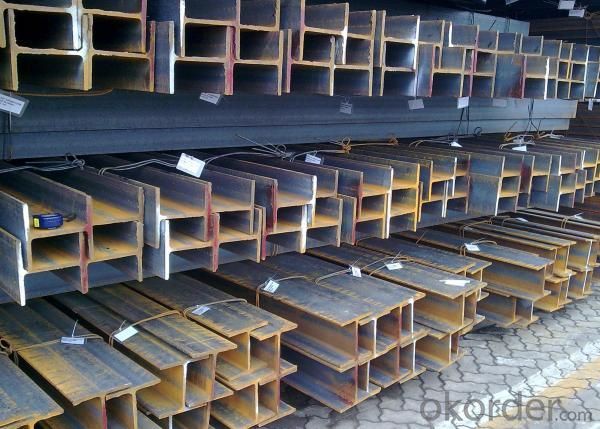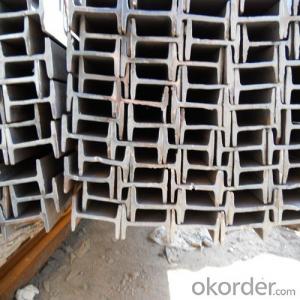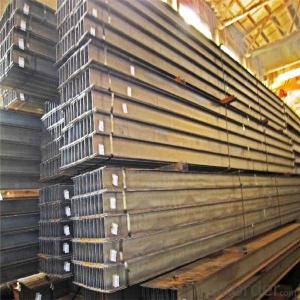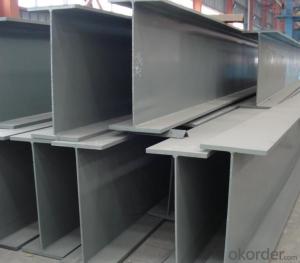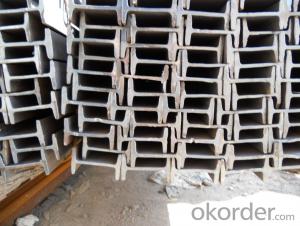Structural Steel H Beam
- Loading Port:
- China Main Port
- Payment Terms:
- TT or LC
- Min Order Qty:
- 100MT m.t.
- Supply Capability:
- 10000MT m.t./month
OKorder Service Pledge
OKorder Financial Service
You Might Also Like
Specifications of Hot Rolled Structural Steel H Beam
1. Standard: GB700-88, Q235B2.
2. Grade: Q235, SS400 or Equivalent
3. Length: 6m,10m, 12m as following table
4. Invoicing on theoretical weight or actual weight as customer request
5.Payment: TT or L/C
6. Sizes:
SIZE(mm) | DIMENSION(kg/m) |
100*100 | 16.9 |
125*125 | 23.6 |
150*75 | 14 |
150*150 | 31.1 |
148*100 | 20.7 |
198*99 | 17.8 |
200*100 | 20.9 |
248*124 | 25.1 |
250*125 | 29 |
Usage & Applications of Hot Rolled Structural Steel H Beam
Commercial building structure ;Pre-engineered buildings; Machinery support structure; Prefabricated structure; Medium scale bridges; Ship-building structure. etc.
Packaging & Delivery of Hot Rolled Structural Steel H Beam
1. Packing: it is nude packed in bundles by steel wire rod
2. Bundle weight: not more than 3.5MT for bulk vessel; less than 3 MT for container load
3. Marks:
Color marking: There will be color marking on both end of the bundle for the cargo delivered by bulk vessel. That makes it easily to distinguish at the destination port.
Tag mark: there will be tag mark tied up on the bundles. The information usually including supplier logo and name, product name, made in China, shipping marks and other information request by the customer.
If loading by container the marking is not needed, but we will prepare it as customer request.
4. Transportation: the goods are delivered by truck from mill to loading port, the maximum quantity can be loaded is around 40MTs by each truck. If the order quantity cannot reach the full truck loaded, the transportation cost per ton will be little higher than full load.
5. Delivered by container or bulk vessel
Production flow of Hot Rolled Structural Steel H Beam
Material prepare (billet) —heat up—rough rolling—precision rolling—cooling—packing—storage and transportation

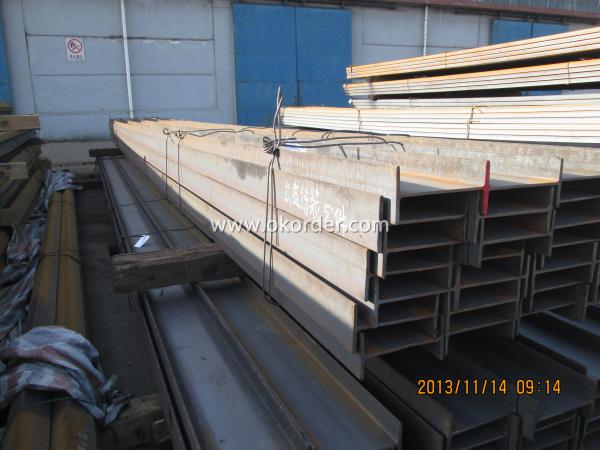
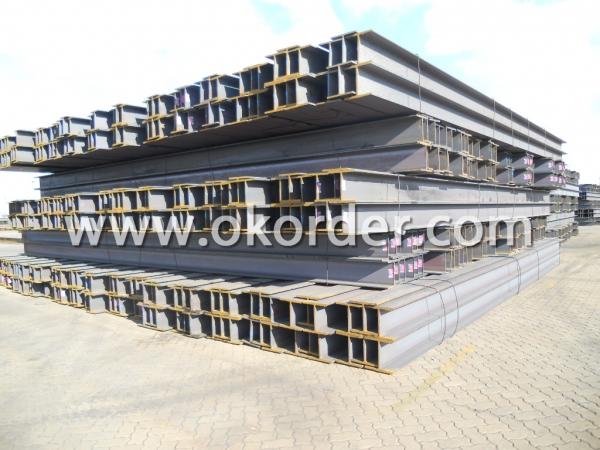
- Q: What are the typical spans and spacing for steel H-beams in roof structures?
- The typical spans and spacing for steel H-beams in roof structures vary depending on the specific design requirements and load calculations. However, in general, the spans for steel H-beams in roof structures can range from 15 to 60 feet, with spacing between beams typically ranging from 5 to 20 feet. It is crucial to consult with a structural engineer or a professional in the field to determine the most appropriate spans and spacing for a specific roof structure.
- Q: Are steel H-beams suitable for modular construction?
- Yes, steel H-beams are suitable for modular construction. H-beams, also known as I-beams or W-beams, are widely used in the construction industry due to their high strength-to-weight ratio and versatility. They are especially suitable for modular construction, a process that involves fabricating building components off-site and assembling them at the construction site. Steel H-beams offer several advantages for modular construction. Firstly, their structural strength allows for the creation of large, open spaces without the need for excessive support columns or walls. This makes them ideal for constructing modular buildings that require flexibility in interior layout and design. Additionally, H-beams are lightweight compared to their load-bearing capacity, making them easier to transport and handle during the modular construction process. Their prefabricated nature also reduces the time and labor required on-site, resulting in faster construction timelines and cost savings. Furthermore, steel H-beams have excellent durability and resistance to environmental factors such as fire, corrosion, and pests. This ensures that modular buildings constructed using H-beams have a longer lifespan and require minimal maintenance. Lastly, steel H-beams can be easily recycled, making them a sustainable choice for modular construction. Their high scrap value and recyclability contribute to reducing the environmental impact of construction projects. In conclusion, steel H-beams are highly suitable for modular construction due to their structural strength, lightweight nature, durability, and sustainability. They allow for the creation of flexible and spacious modular buildings while reducing construction time and costs.
- Q: Can Steel H-Beams be used in residential housing or apartment buildings?
- Certainly! Residential housing or apartment buildings can indeed utilize Steel H-Beams. These beams are highly favored in construction for their robustness, longevity, and adaptability. They possess exceptional load-bearing abilities, rendering them appropriate for sizable structures such as residential housing and apartment buildings, where substantial burdens must be upheld. Furthermore, Steel H-Beams possess the added benefit of being lightweight when compared to alternatives like wood or concrete, granting greater freedom in design and facilitating construction. By incorporating these beams into residential and apartment buildings, the overall stability and integrity of the structure are ensured, thus establishing them as a dependable choice for construction endeavors.
- Q: What is the purpose of using H-beams?
- H-beams, also known as I-beams or universal beams, serve a crucial purpose in the construction industry. The primary purpose of using H-beams is to provide structural support and strength to various structures, including buildings, bridges, and other infrastructure projects. One of the key advantages of H-beams is their unique shape, which resembles the letter "H" when viewed from the cross-section. This design allows H-beams to distribute weight evenly and efficiently, making them ideal for carrying heavy loads and resisting bending or deflection. The top and bottom flanges of the beam provide resistance against compressive and tensile forces, while the web in between ensures stability and prevents buckling. The purpose of using H-beams is to create a stable and durable framework for various structures, ensuring their longevity and safety. H-beams are frequently used in the construction of high-rise buildings, as they can support significant vertical loads, such as the weight of multiple floors, walls, and equipment. Additionally, H-beams are commonly utilized in bridge construction, where their strength and load-bearing capacity are crucial. By using H-beams, engineers can design bridges that can withstand heavy traffic loads and environmental forces, ensuring the safety and functionality of these critical transportation structures. Furthermore, H-beams find applications in industrial structures, such as warehouses and factories, where they provide the necessary support for heavy machinery, cranes, and storage systems. The robustness and stability of H-beams make them an excellent choice for such applications, ensuring the integrity and functionality of the structures. In summary, the purpose of using H-beams is to provide structural support and strength to various construction projects, including buildings, bridges, and industrial structures. Their unique shape and design allow for efficient weight distribution, resistance against bending, and overall stability, making them an essential component in modern construction practices.
- Q: Can steel H-beams be painted or coated?
- Yes, steel H-beams can be painted or coated. Painting or coating the steel H-beams helps to protect them from corrosion, improves their aesthetics, and provides additional resistance to wear and tear. Before painting or coating, it is important to properly clean and prepare the surface to ensure good adhesion. The specific type of paint or coating used will depend on factors such as the environmental conditions and desired finish. It is recommended to consult with a professional or follow the manufacturer's guidelines to ensure the correct paint or coating is chosen and applied correctly.
- Q: Can steel H-beams be used in the construction of schools or educational buildings?
- Yes, steel H-beams can definitely be used in the construction of schools or educational buildings. Steel H-beams are commonly used in construction due to their strength, durability, and versatility. They provide structural support and are capable of withstanding heavy loads, making them suitable for large-scale buildings like schools. Moreover, steel H-beams can be easily fabricated and installed, reducing construction time and costs. Additionally, steel is a sustainable material as it is recyclable, making it an environmentally friendly choice for educational buildings. Overall, the use of steel H-beams in the construction of schools and educational buildings ensures a safe and long-lasting structure, meeting the necessary standards and requirements for such facilities.
- Q: Can steel H-beams be used in temporary structures?
- Yes, steel H-beams can be used in temporary structures. H-beams are widely used in construction due to their strength, durability, and versatility. They are commonly used in the construction of temporary structures such as scaffolding, temporary bridges, or support structures for temporary stages or platforms. Steel H-beams are designed to carry heavy loads, making them suitable for temporary structures that require stability and structural integrity. Additionally, their modular design allows for easy assembly and disassembly, making them ideal for temporary applications.
- Q: Are steel H-beams suitable for rooftop structures?
- Yes, steel H-beams are suitable for rooftop structures. Steel H-beams are known for their strength and durability, making them an ideal choice for supporting heavy loads on rooftops. They are capable of withstanding the weight of various rooftop structures such as solar panels, HVAC systems, and equipment. Steel H-beams provide excellent structural support, ensuring the stability and safety of the rooftop structure. Additionally, steel H-beams are resistant to corrosion and have a longer lifespan compared to other materials, making them a reliable choice for rooftop applications.
- Q: How do Steel H-Beams contribute to the overall indoor air quality of a building?
- The overall indoor air quality of a building is not directly affected by steel H-Beams. Factors such as ventilation systems, building materials, and maintenance practices primarily influence indoor air quality. However, steel H-Beams can indirectly contribute to better indoor air quality by providing structural integrity to the building. These beams are commonly used in load-bearing applications and can support the weight of the structure, reducing the risk of structural damage or collapse. This can help prevent the entry of outdoor pollutants such as allergens, dust, and moisture, which may degrade indoor air quality. Moreover, steel H-Beams are recognized for their durability and resistance to moisture, mold, and pests. Their non-porous surface makes it challenging for mold to grow, decreasing the chances of mold spores being released into the air. This can help maintain a healthy indoor environment. It is essential to consider that while steel H-Beams may have some indirect benefits for indoor air quality, optimal indoor air quality in a building should be ensured by considering other factors such as proper ventilation, use of low-emission building materials, and regular maintenance.
- Q: Can steel H-beams be used for sports arenas?
- Yes, steel H-beams can be used for sports arenas. They are commonly used for structural support in large and complex building projects, including sports arenas, due to their strength, durability, and ability to withstand heavy loads. The use of steel H-beams provides a reliable and sturdy framework for the construction of sports arenas, ensuring the safety and stability of the structure.
1. Manufacturer Overview
| Location | Tangshan, China |
| Year Established | 2007 |
| Annual Output Value | Above US$ 80 Million |
| Main Markets | Mid East; Southeast aisa; korea |
| Company Certifications |
2. Manufacturer Certificates
| a) Certification Name | |
| Range | |
| Reference | |
| Validity Period |
3. Manufacturer Capability
| a) Trade Capacity | |
| Nearest Port | Tianjin; |
| Export Percentage | 20% - 25% |
| No.of Employees in Trade Department | 11-15 People |
| Language Spoken: | English; Chinese |
| b) Factory Information | |
| Factory Size: | Above 75,000 square meters |
| No. of Production Lines | 1 |
| Contract Manufacturing | OEM Service Offered; |
| Product Price Range | Average |
Send your message to us
Structural Steel H Beam
- Loading Port:
- China Main Port
- Payment Terms:
- TT or LC
- Min Order Qty:
- 100MT m.t.
- Supply Capability:
- 10000MT m.t./month
OKorder Service Pledge
OKorder Financial Service
Similar products
Hot products
Hot Searches
Related keywords





